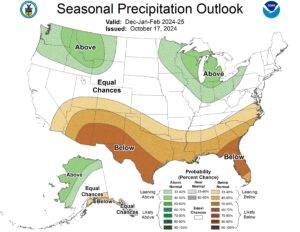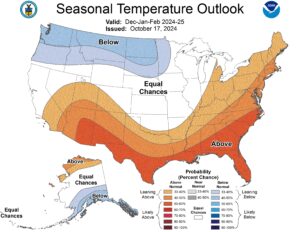2024-2025 Winter Outlook
October 17, 2024, – Forecasters at NOAA’s Climate Prediction Center released the 2024-25 U.S. Winter Outlook.
“A slowly-developing La Nina is favored to influence conditions for the upcoming winter across most of the country, according to NOAA’s U.S. Winter Outlook released today by the Climate Prediction Center — a division of NOAA’s National Weather Service. This outlook is for December 2024 through February 2025 and contains information on likely conditions throughout the country for temperature, precipitation and drought.
This winter, NOAA predicts wetter-than-average conditions for the entire northern tier of the continental U.S., particularly in the Pacific Northwest and the Great Lakes region, along with northern and western Alaska. Meanwhile, drier-than-average conditions are expected from the Four Corners region of the Southwest to the Southeast, Gulf Coast and lower mid-Atlantic states. “
The 2024-25 U.S. Winter Outlook (December through February):
Precipitation
- Wetter-than-average conditions are most likely in the Great Lakes states, and above-average precipitation is also favored in northern and western Alaska, the Pacific Northwest and across the northern tier of the U.S. These probabilities are strongest in portions of Ohio, Indiana and Kentucky.
-
The greatest likelihood for drier-than-average conditions are in states bordering the Gulf of Mexico, as well as in Texas and southern New Mexico.
- Much of California, the central Plains states and the I-95 corridor from Boston to Washington, D.C., have equal chances of below-average, near-average or above-average seasonal total precipitation.
Temperature
- Warmer-than-average temperatures are favored from the southern tier of the U.S. to the eastern Great Lakes, eastern seaboard, New England and northern Alaska. These probabilities are strongest along the Gulf Coast and for most of Texas.
-
Below-average temperatures are most likely in southern Alaska, with below-average temperatures slightly favored from the Pacific Northwest to the northern High Plains.
- The remaining areas have equal chances of below-, near-, or above-average seasonal mean temperatures.
NOAA’s seasonal outlooks provide the likelihood that temperatures and total precipitation amounts will be above-, near- or below-average, and how drought conditions are anticipated to change in the months ahead. The outlook does not project seasonal snowfall accumulations as snow forecasts are generally not predictable more than a week in advance.
NOAA’s Climate Prediction Center updates the three-month outlook each month. The next update will be available November 21, 2024.




